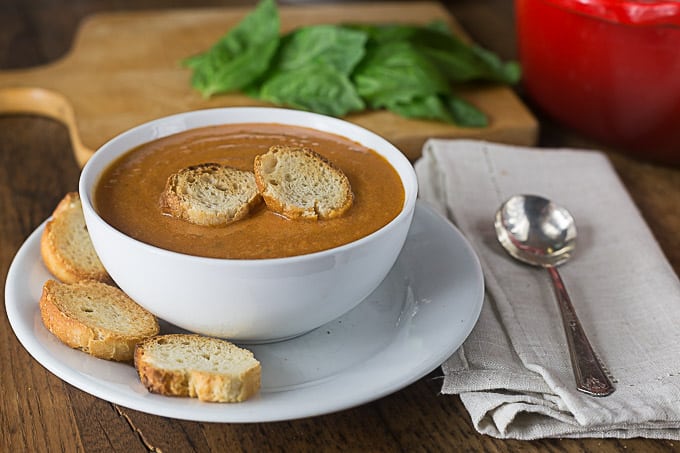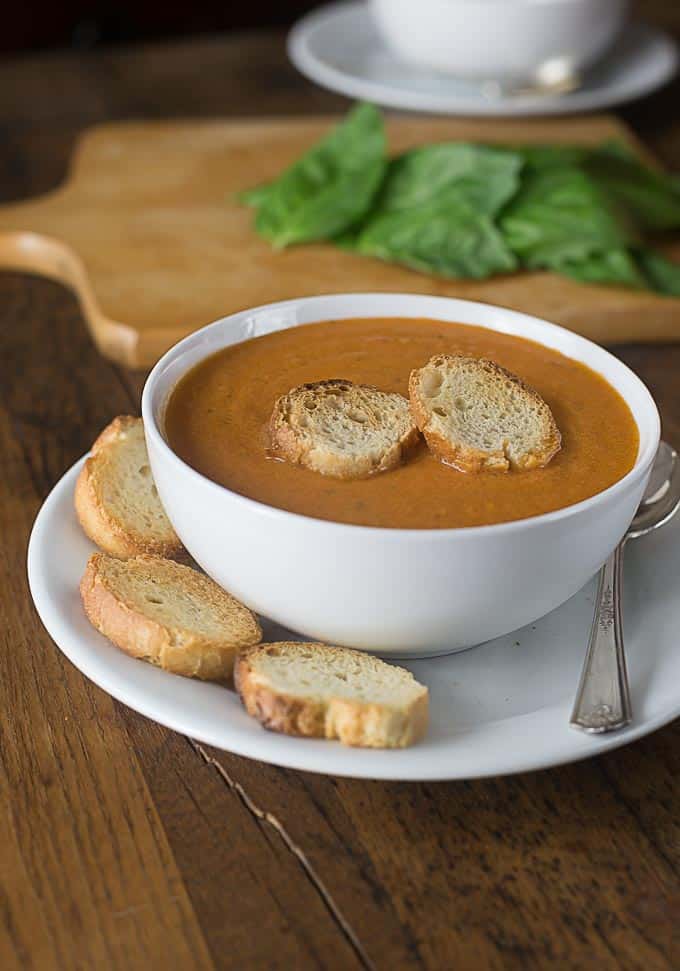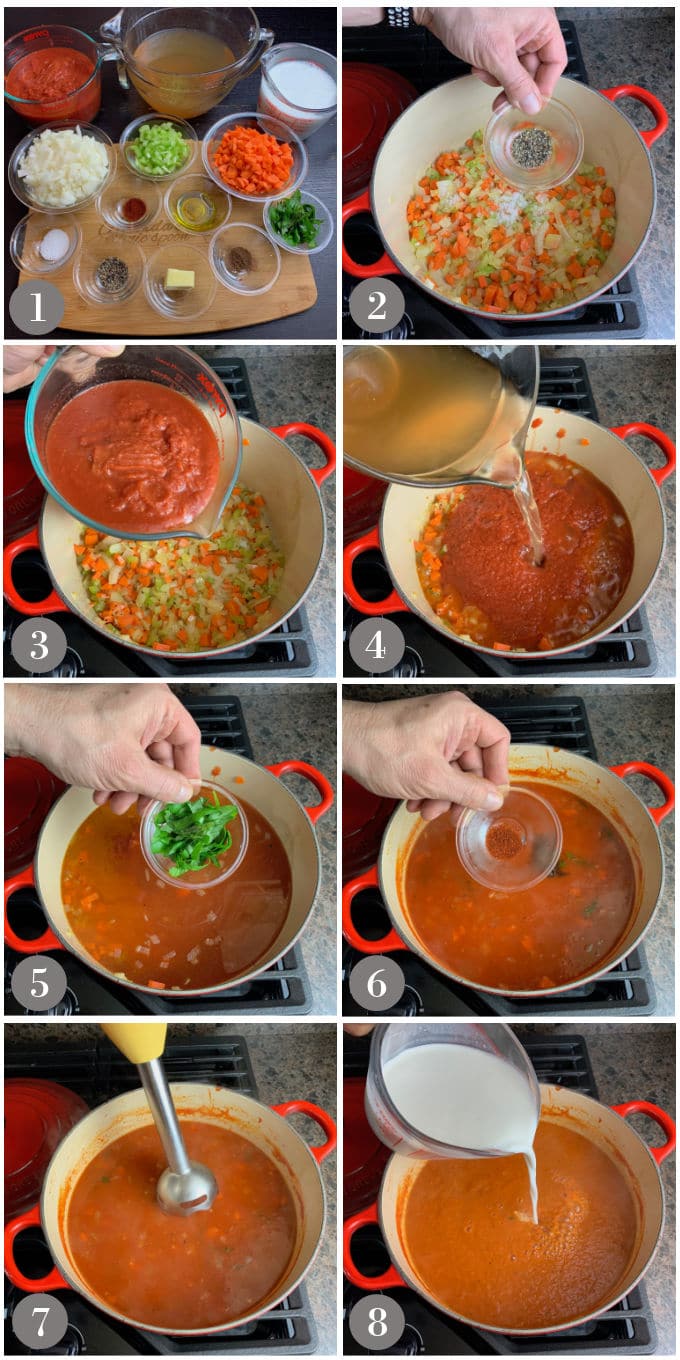If anything says comfort food, it's soup. We all have our favorites, don't we? Mine? Creamy tomato basil bisque!

Jump to:
Soup vs. Bisque
Okay, before I go on, I just want to explain the difference between soup and bisque. What is bisque? Bisque is basically a rich creamy soup. Creamy you say? I am all over that one! It goes amazingly well with a grilled cheese sandwich. Memories of childhood!!! But, this is not the soup of my childhood. It's a new and improved version. Very much improved!
Until recently, a creamy tomato bisque was one of those things I would pick up at my university's cafeteria when I had little or no time for lunch. Then a couple of months ago my son, the aspiring chef, brought home some from the country club where he works. It was comfort food in a Styrofoam container. He said he had seen the chef make it and that it was not too difficult. "We can do this at home", mom, he said. So, I thought, how hard can it be to replicate a recipe for tomato bisque? Just a handful of ingredients, right? You bet!

Tomato bisque is perfect for a quick weeknight meal or packed lunch. I used a quality canned tomatoes. In the dead of winter, using canned tomatoes is not a bad idea. All you need to make this creamy tomato bisque are a few ingredients. If at all possible, use fresh basil, it makes all the difference in the world. I've been enjoying this soup for the past couple of days at work with a little sprinkling of Parmesan cheese and a piece of crusty bread. Yesterday I forgot the bread in my rush to run out the door. Oh, no what to do? I went to my friend's office, she always has crackers! It was still good.
Tomato history
Tomatoes originated in the new world. Explorers took them back to Europe where at first no one knew what to make of the tomato or how to use it. Because of its bright beautiful color, they were often used as ornamental plants. In America the early colonists would not use tomatoes thinking them to be poisonous. We've come a long way since!
Basil history
Basil is a member of the mint family and has a rich history spanning thousands of years. It is believed to have originated in tropical regions of Asia, particularly India and Southeast Asia, though some accounts suggest parts of Africa as well. The plant has been cultivated for over 5,000 years.
Step by step photos:

- Gather all the ingredients and have them measured, chopped and ready to go.
- In a soup pot or Dutch oven on medium heat add the olive oil and butter. Sauté the celery, carrots and onions. Stir frequently until the onions are translucent. Add the salt and pepper.
- Add the tomatoes and stir to combine.
- Pour in the vegetable broth.
- Add basil that has been cut into strips. Turn the heat to high and bring to a boil then reduce to a simmer for about 10 minutes.
- Next add the cayenne and allspice.
- Using an immersion blender, crush all the ingredients until smooth.
- Stir in the half and half and cook for another 10 minutes uncovered.
Frequently asked questions:
- How long can I save this soup? You can store in the refrigerator for up to 3 days in an airtight container.
- Can I freeze this soup? No, since this soup contains dairy and it is best not to freeze because it will separate and will have a very grainy texture when thawed.
Want more comforting soup recipes to enjoy this winter?
Butternut Squash Apple Soup - A creamy, good-for-you soup that goes great with crusty bread. Try it this week.
Turkey Burger Soup - Turkey burger soup is the perfect comfort food on a chilly day. It's creamy and you can make a big batch and freeze it for later.
Looking for more recipes?
Sign up for my free recipe newsletter to get new recipes in your inbox each week! You can also find me sharing more inspiration in Pinterest and Facebook

Creamy Tomato Basil Bisque Recipe
Ingredients
- 2 Tbsp olive oil
- 1 Tbsp unsalted butter
- ½ cup celery diced
- 1 cup carrots diced
- 1 onion large, diced
- 1 tsp Kosher salt
- ½ tsp black pepper cracked
- 28 oz crushed tomatoes 1 can
- 4 cups vegetable broth
- 10 basil leaves cut into strips
- ¼ tsp allspice
- ¼ tsp cayenne
- 2 cups half and half
Instructions
- In a soup pot or Dutch oven place olive oil and butter. Sauté the celery, carrots and onions until translucent.
- Sprinkle with salt and pepper. Add the tomatoes, vegetable broth, and basil. Bring to a boil. Reduce heat to medium and simmer for about 10 minutes. Add the allspice and cayenne.
- Using an immersion blender, carefully crush all the ingredients. Stir in the half and half and cook for an additional 10 minutes uncovered.
Nutrition
Originally published March 2016 and updated September 2020.






Denise Wright
This sounds yummy! I like the cayenne and allspice. Can't wait to try it. It's rainy and bleak here in Pittsburgh so it would have been the perfect day for it.
Analida
It's rainy, bleak here in Erie too! 🙁 Tonight, my son is making dinner: Shrimp Bisque. He's made it before. I will have to blog it soon.
Joy @ Joy Love Food
It is rainy and cold here in MA too, I would love a bowl of this soup for dinner tonight, it looks so creamy and comforting!
Analida
It is very comforting. Don't forget the grilled cheese sandwich! 🙂
Jeannie Johansen
This sounds really good! For some unknown reason I have never tried making tomato soup. This sounds doable, I think I will try it
Analida
Jeannie, give it a go! You will be surprised at how easy it is. 🙂
Kristen
Oh this is such a beautiful soup that is so full of flavor! I can not wait to warm up with a bowl of this!
Analida
🙂 I just had some of the leftovers today at work! It is a beautiful soup. Thanks!!!
Jade @ Jonesin' For Taste
Tomato Basil soup is one of my all time favorites as well! Such a classic recipe and really not that hard to make.
Analida
Yes, it is such a classic and so easy to make.
Debra @ Bowl Me Over
Mmmm....tomato soup is just the best! Thank you for sharing with us at #FoodieFriDIY - stopped by to do some sharing and to thank you for linking up!
Analida
Hi Debra! You are welcome. I love tomato soup, especially this time of year.
April J Harris
I agree, soup is one of the ultimate comfort foods! Love this flavourful bisque. I'm fascinated by the addition of the allspice and cayenne - I'm sure they add fantastic flavour. Pinned. Thank you so much for sharing with Hearth and Soul. Hope to 'see' you again this week!
Analida
Hi April. I was thinking the other day about making this soup. It's definitely great to take to my office in my lunch.
Yes, the allspice and cayenne are great additions.
Michelle
I never really liked tomato soup until recently. Your bisque looks absolutely divine. I'd pair it with a panini for dinner!
Analida
Thanks Michelle!
I love tomato soup, especially during the cold weather. Yes, a panini is perfect!
Liz @ I Heart Vegetables
My husband and I both LOVE a creamy tomato soup (especially with a crusty grilled cheese on the side!) So this soup looks perfect!
Analida
Thanks Liz! Yes, tomato soup is so perfect with a crusty grilled cheese! I am getting hungry for some, LOL
Carol Borchardt
Love a good tomato soup! This looks wonderful and so perfect with grilled cheese!
Analida
Thanks for commenting Carol! Tomato soup is one of my favorites, especially in winter.
Mallory Smith
Hi! I am making this soup for a crowd. I need to serve 16 and soup is the main entree. What is the serving size here? How many cups per serving?
Thank you!